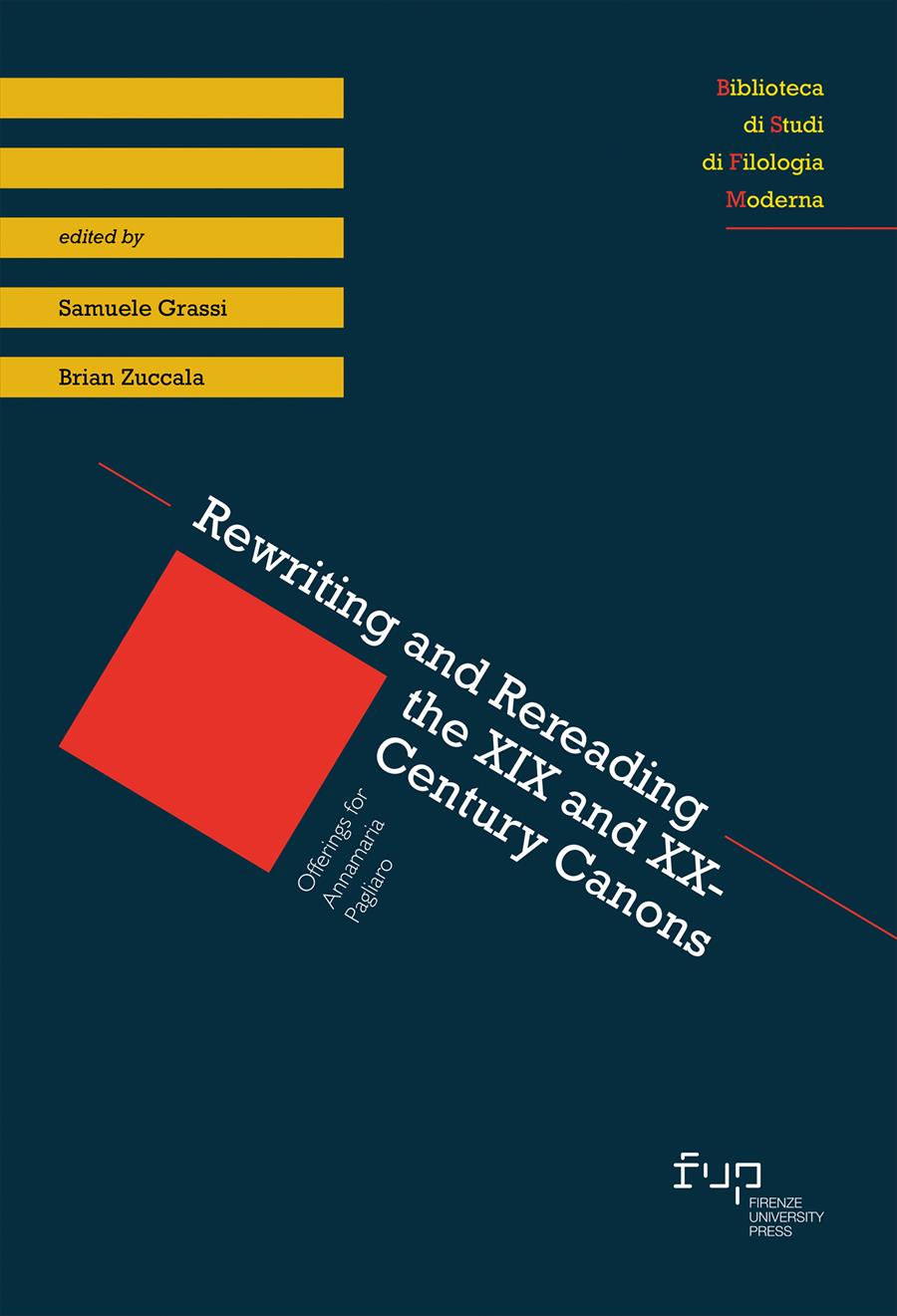- Rewriting and Rereading the XIX and XX-Century Canons
- Edited by Samuele Grassi, Brian Zuccala
Italy and George Gissing: A Geocritical Approach
- Luigi Gussago
- © 2022 Author(s) |
- CC BY 4.0
- DOI: 10.36253/978-88-5518-597-4.10
Victorian novelist George Gissing (1857-1903) was a devotee of ancient Roman culture and visited Italy three times between 1888 and 1897. In spite of this admiration, his relationship with Italy was problematic, largely due to personal mishaps. In light of these conflicting views, my essay considers Gissing’s portrayals of mostly Southern Italian locations through his fiction, letters, and travelogues. The focus lies here not so much on the narrator but on the narrated space, with Bertrand Westphal’s notion of “geocriticism” at its theoretical core. Far from being a utopian haven, Gissing’s Italy emerges as a trans-cultural meeting point where the perception of an “interiorised place” can reshape reality, alter horizons, and redefine established values.
- Keywords:
- Geocriticism,
- Gissing,
- Place,
- Spatiotemporality,
- Westphal,
La Trobe University, Australia - ORCID: 0000-0002-2448-3743
- Anonymous. 2021. “Notes and News.” The Gissing Journal 55, 4: 40-41.
- Bakhtin, Mikhail Mikhaĭlovich. 1981. The Dialogic Imagination: Four Essays, edited by Michael Holquis, translated by Carly Emerson, Michael Holquist. Austin: University of Texas Press.
- Bakhtin, Mikhail Mikhaĭlovich. 2012. Sobranie sočinenij, T. 3, Teorija romana (1930-1961), edited by S.G. Bocharov, V.V. Kozhinov. Moskva: Yazyki Slavyanskikh Kultur.
- Coustillas, Pierre, and Colin Partridge, edited by. 1995. George Gissing: The Critical Heritage. London-New York: Routledge.
- Findlater, Jane H. 1904. “The Spokesman of Despair.” The Living Age, volume CCXLIII, 733-741. Boston: The Living Age Company. Reprinted in Pierre Coustillas, and Colin Partridge, edited by. 1995. George Gissing: The Critical Heritage, 456-466. London-New York: Routledge.
- Gissing, George. 1931 (1927). Letters of George Gissing to Members of His Family, compiled by Algernon Gissing, and Ellen Gissing. London: Constable & Company Ltd.
- Gissing, George. 1968 (1884). The Unclassed. New York: AMS Press.
- Gissing, George. 1985 (1890). The Emancipated. London: The Hogarth Press.
- Gissing, George. 1992. The Collected Letters of George Gissing, 3 (1886-1888), edited by Paul F. Mattheisen, Arthur C. Young, and Pierre Coustillas. Athens: Ohio University Press.
- Gissing, George. 1993. The Collected Letters of George Gissing, 4 (1889-1891), edited by Paul F. Mattheisen, Arthur C. Young, and Pierre Coustillas. Athens, Ohio University Press.
- Gissing, George. 1995. The Collected Letters of George Gissing, 7 (1897-1899), edited by Paul F. Mattheisen, Arthur C. Young, and Pierre Coustillas. Athens: Ohio University Press.
- Gissing, George. 1996 (1901). By the Ionian Sea. Marlboro: The Marlboro Press.
- Hutcheon, Rebecca. 2021. “Mapping Gissing’s Chronotopes from Text to Code to Graph.” The Gissing Journal 55, 4: 22-40.
- Orwell, George. 1943. “ ‘Not Enough Money’. A Sketch of George Gissing.” Tribune, 2 April, 1943.
- Orwell, George. 1960. “George Gissing.” London Magazine 7, 6: 36-43.
- Roberts, Morley. 1912. The Private Life of Henry Maitland. A Record Dictated by J.H. London: Eveleigh Nash.
- Schank Daley, Norma L. 1942. “Some reflections on the Scholarship of George Gissing.” The Classical Journal 38, 1: 21-30.
- Swinnerton, Frank. 1912. George Gissing: A Critical Study. London: Martin Secker.
- Tally, Robert T. Jr. 2011. “Translator’s Preface. The Timely Emergence of Geocriticism.” In Bertrand Westphal. Geocriticism: Real and Fictional Spaces, translated by Robert T. Tally Jr, ix-xiii. New York: Palgrave Macmillan.
- Tuan, Yi-Fu. 2002 (1977). Space and Place: The Perspective of Experience. Minneapolis-London: University of Minnesota Press.
- Wells Herbert G. 1904. “George Gissing: An Impression.” Eclectic Magazine of Foreign Literature, Science, and Art 143, 5: 580-587. First appeared in Monthly Review 16, 47: 160-172, 1904.
- Westphal, Bertrand. 2000. “Pour une approche géocritique des textes.” in La Géocritique mode d’emploi, sous la direction de Bertrand Westphal, 9-40. Limoges: PULIM. https://sflgc.org/bibliotheque/westphal-bertrand-pour-une-approche-geocritique-des-textes/
- Westphal, Bertrand. 2007. La Géocritique: réel, fiction, espace. Paris: Minuit.
- Westphal, Bertrand. 2008. “Oltre la torre d’avorio. Genesi della geocritica.” In Lezioni di dottorato 2007, a cura di Roberto Baronti Marchiò, 257-271. Santa Maria Capua Vetere: Edizioni Spartaco.
- Westphal, Bertrand. 2011a. Geocriticism: Real and Fictional Spaces, translated by Robert T. Tally Jr. New York: Palgrave Macmillan.
- Westphal, Bertrand. 2011b. “Spazio, luogo, frontiera. Dante e l’orizzonte.” Between 1, 1: 1-13.
Chapter Information
Chapter Title
Italy and George Gissing: A Geocritical Approach
Authors
Luigi Gussago
Language
English
DOI
10.36253/978-88-5518-597-4.10
Peer Reviewed
Publication Year
2022
Copyright Information
© 2022 Author(s)
Content License
Metadata License
Bibliographic Information
Book Title
Rewriting and Rereading the XIX and XX-Century Canons
Book Subtitle
Offerings for Annamaria Pagliaro
Editors
Samuele Grassi, Brian Zuccala
Peer Reviewed
Publication Year
2022
Copyright Information
© 2022 Author(s)
Content License
Metadata License
Publisher Name
Firenze University Press
DOI
10.36253/978-88-5518-597-4
eISBN (pdf)
978-88-5518-597-4
eISBN (xml)
978-88-5518-598-1
Series Title
Biblioteca di Studi di Filologia Moderna
Series E-ISSN
2420-8361
